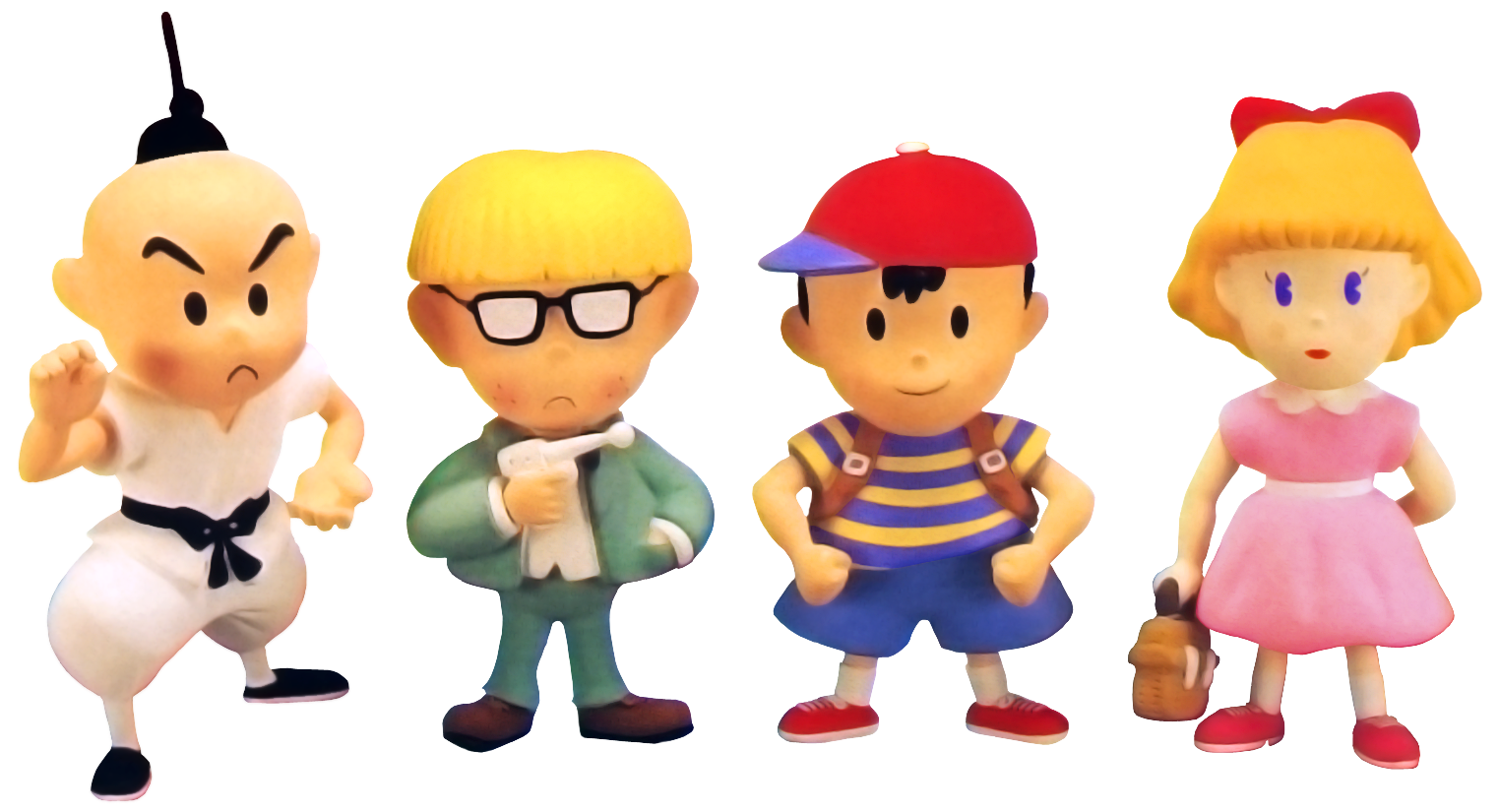Table of Contents Show
Twenty-six years ago today, in 1995, “Earthbound,” the second installment of the Japanese “Mother” franchise published by Nintendo, was finally released in the US on the Super Nintendo Entertainment System (SNES) as a standalone role-playing video game. The quirky game focuses on four kids traveling through colorful cities, jungles, deserts, and even dreamscapes to collect eight sound melodies to aid in defeating Giygas — an alien warlord intent on taking over Earth. The RPG utilizes a turn-based system with both melee and psychic attacks at the forefront. Initially, the game opened in the US market with less than stellar sales — some attest this fact to Nintendo’s marketing strategy of using the tagline “This game stinks,” in hopes of riding the 90s’ body humor train, complete with purposely unpleasant scratch-and-sniff cards included in the game’s guidebook.

“Earthbound” Becomes A Cult Favorite
The game has a unique sense of humor, often breaking the fourth wall and inserting popular culture references into its dialogue and soundtrack. It also doesn’t seem to take itself too seriously, resulting in lovable characters and unusual quests. Additionally, each of the four protagonists have their own ability list comprised of different psychic powers and weapons, which drives the player to strategize each enemy encounter in a different way; this interesting strategizing aspect of combat increases the game’s replay value. Thus, over the years, “Earthbound” has garnered the attention it lacked during its release, most notably through the addition of Ness, the game’s main protagonist, to the “Super Smash Bros.” franchise, which introduced a variety of audiences to the relatively unknown “Earthbound.” With its growing notoriety and popularity, the game itself and its accompanying Player’s Guide reach sale prices in the hundreds or even thousands of dollars, depending on the condition.
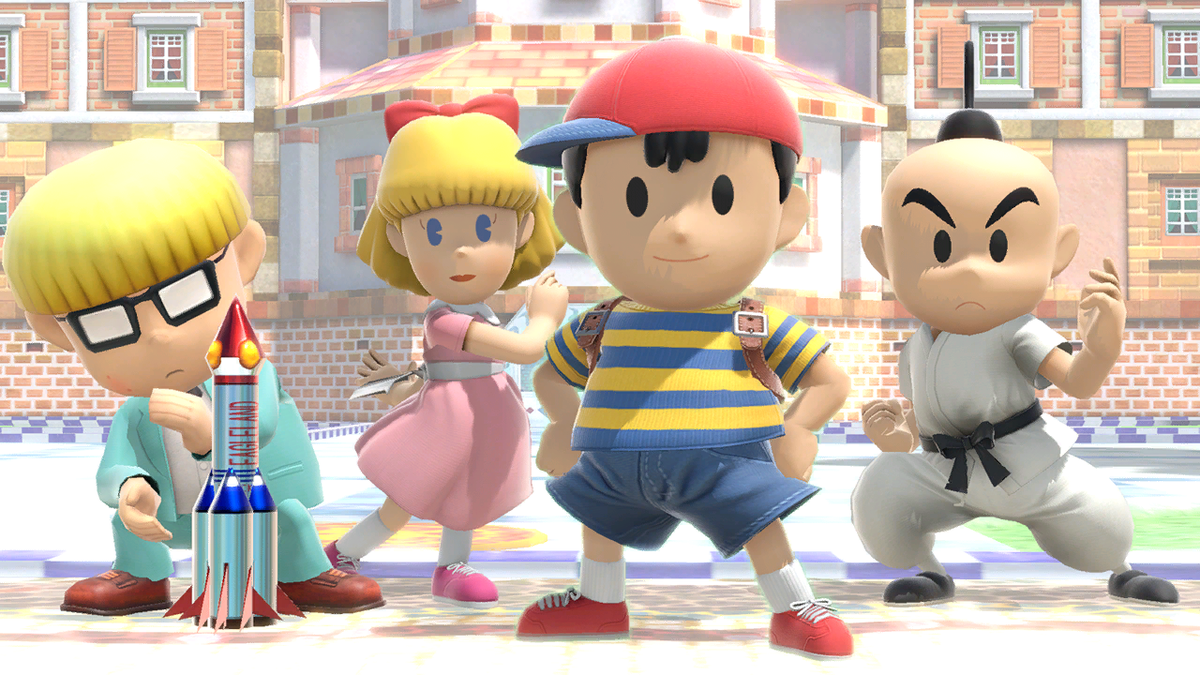
Profit aside, more modern games such as “Undertale” (2015) have drawn inspiration from “Earthbound’s” art and dialogue style, further proving the game’s long-lasting influence. “Undertale’s” creator, Toby Fox, is a long-time fan of “Earthbound” and even created a Halloween romhack of “Earthbound.” With this romhack, Toby Fox modified the ROM file for “Earthbound” to alter the appearance and dialogue and turned it into a monster mystery. Fox’s admiration for “Earthbound” also led to multiple dialogue references within “Undertale.” One such quote comes from the character Sans, “On days like these, kids like you…” which is a reference to a cop in “Earthbound,” saying, “At times like this, kids like you should be playing Nintendo games.” The pixelated graphics style of “Undertale” is also incredibly reminiscent of “Earthbound’s” 16-bit style.
The Prophetic Gang Of Four
There are four playable characters in the game, with each being added to the troupe one at a time as the game progresses. By having four, “Earthbound” showcases the value of teamwork; they each add a different flavor to the battles and work to each other’s strengths. It is also made apparent that defeating Giygas is only possible if they are able to work together as a team. Ness is the game’s starting hero, equipped with his trusty baseball bat and cap to match. He’s a seemingly ordinary kid who’s quick to rise at the sight of danger.
It’s during his exploration of a meteor landing that he learns about a prophecy where he and three other kids foil Giygas’ evil plans to take over planet Earth. He travels in search of the other kids (sometimes while riding his speedy and rented bicycle) and comes across a variety of characters, including a time-traveling bee named Buzz-Buzz, corrupt police officers, and an eccentric treasure hunter, to name a few. He acts as the player’s insert into the game and has no dialogue of his own.
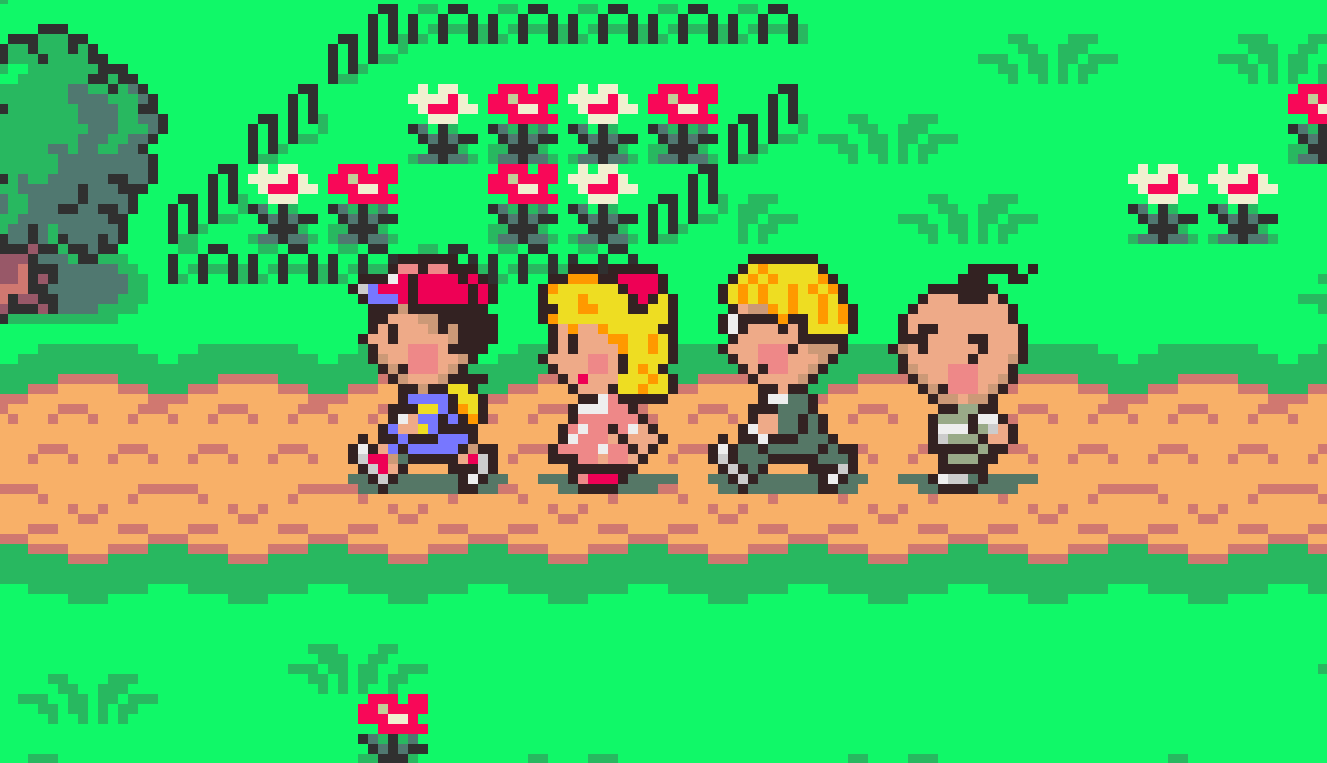
Paula, the only girl, is the second playable character and is the most psychically powerful of the group. Her family runs a preschool in her local town where everyone talks fondly of her. She’s also seen styling a pink dress and her signature red hair bow. While she is able to pack a punch in combat against Giygas’ mind-controlled minions, her true power is her ability to telepathically communicate to others. She, too, found out about the prophecy of the four kids and used her telepathic power to reach out to the others to fulfill it.
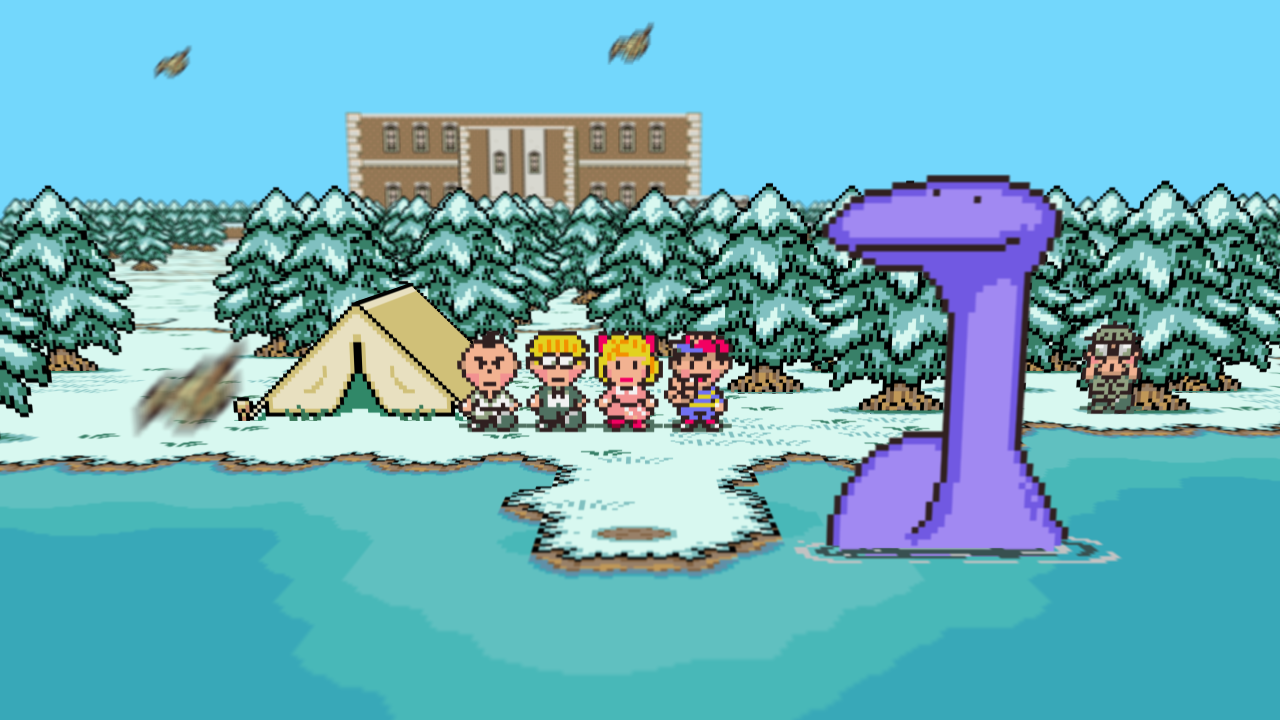
Jeff is the third playable character who the player comes across in a snow-laden land aptly named Winters. The son of a scientist, Jeff is the only character who uses his own inventions to battle, as he has no psychic abilities like the others. Jeff hears Paula’s psychic cry for help in the middle of the night at his boarding school. He quickly travels through Winters’ snowy landscape, finding a man obsessed with puzzles, a monkey who’s extremely fond of chewing gum, and rides a friendly version of the Loch Ness Monster along the way.
Poo is the last member of the group to join the party. Poo isn’t an ordinary kid like the others, but rather the prince of his land Dalaam. Poo is extremely powerful from the start and is the only character who has prior experience using his psychic abilities. He actually goes to one of his surprisingly disturbing meditation sessions during the game’s playtime; Poo’s meditation session, or Mu training, involves allowing the spirit of his lineage to break his legs, tear his arms off, cut his ears off, and take out his eyes. He also leaves mid-game for a period of time to learn the power of teleportation, greatly aiding the group in their journey.
Battle Tactics
Part of the game’s battle system allows the player to purchase and equip character-specific weapons for melee attacks, should the player choose to go that route. These weapons can be found in different areas of the game, increasing in strength as the game increases in difficulty. Ness can only equip baseball bats, with a total of fourteen throughout the game. Similarly, Jeff has fourteen different guns, and Paula has a total of eight frying pans to equip. On the other hand, Poo’s character is more psychic-ability based and only has one sword that the player can find to equip for him. While Jeff does not have any psychic abilities, he is the only character who is able to use secondary weapons such as bombs, bottle rockets, and heavy bazookas to inflict maximum damage on enemies. The other three characters, however, have many psychic attacks to choose from, including the following, with checkmarks indicating who possesses which abilities:
| Ness | Paula | Jeff | Poo | |
| PSI Lifeup | ✓ | ✓ | ||
| PSI Fire | ✓ | |||
| PSI Freeze | ✓ | ✓ | ||
| PSI Shield | ✓ | ✓ | ✓ | |
| PSI Teleport | ✓ | ✓ |
While there are many psychic attacks and powers to choose from, some work better in certain situations. This forces the player to strategize which attacks to use with which characters; the Carbon Dog boss battle exemplifies this. The Carbon Dog is the Sanctuary Guardian that guards the final of the eight sound melodies needed to defeat Giygas and can be found in the Fire Spring.
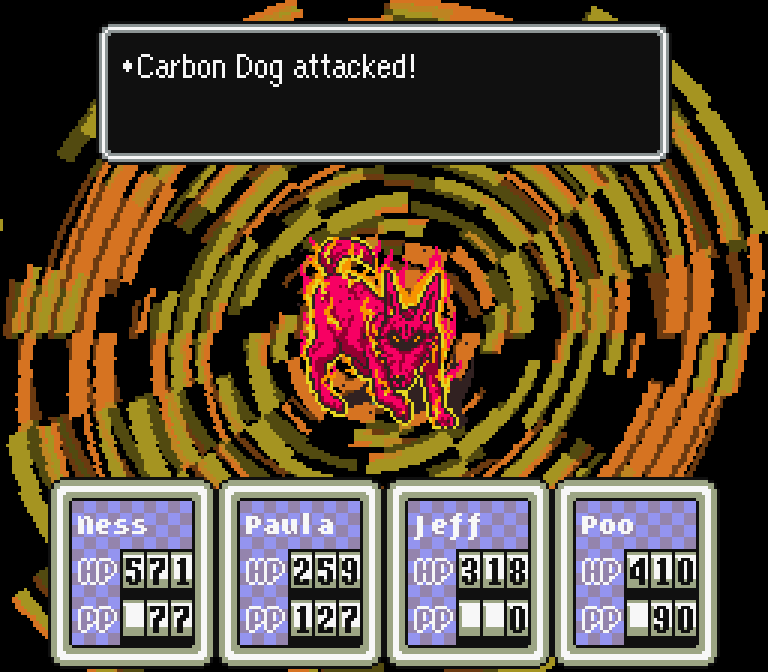
Since the Carbon Dog is found in the heat-based Fire Spring, it’s invulnerable to fire attacks and susceptible to ice attacks. The best strategy would be to use Poo and Paula’s PSI Freeze attack to do damage to the Carbon Dog. Because Ness does not have the PSI Freeze ability, he would be better equipped to use PSI Lifeup to heal any characters who have taken damage during the battle. Additionally, Jeff could deal additional damage with his bazooka attacks. This is one example of the battle dynamics that change with each new enemy encounter.
Rock, Paper, Friendship
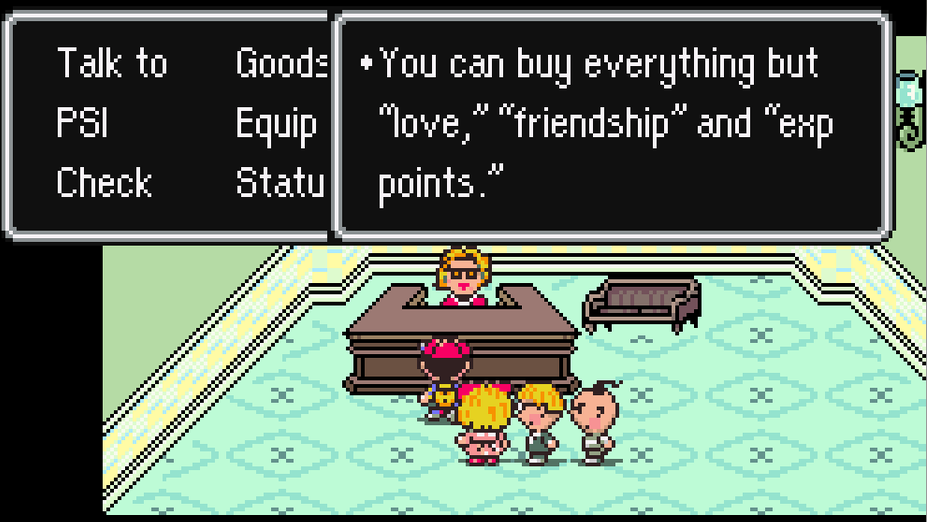
When played in healthy amounts, video games immerse players in situations that can call attention to real issues in their own lives. “Earthbound” utilizes in-game consequences to allow the player to work through their problems without the weight of their real-life counterparts. While “Earthbound” utilizes its playable group of four’s varying battle styles to advocate for the value of teamwork, it also reinforces this concept in the storyline itself. The four playable characters not only have each other, but throughout the game have an array of non-player companions aiding in the journey: Bubble Monkey (a monkey who helps Jeff across a body of water for a piece of gum), Tracy (Ness’s younger sister who stores items for the group), The Runaway Five (a financially struggling on-the-road music group who gives the gang a ride through a ghost-haunted tunnel), Apple Kid, Gerardo Montague, and Dr. Andonuts (two inventors and a construction worker who create the Phase Distorter that allows the playable characters to reach Giygas for the final battle) and the Saturn Valley residents (tiny alien creatures who restore your health at no cost and are the definition of hospitality), to name a few of many!
The theme might be something like relief at having others around you, and not being some lowly human all by yourself. To stretch the point a bit, I could say that if I were the only one on the entire planet, it wouldn’t be any fun at all.
Shigesato itoi, Creator of “Earthbound“
By designing certain NPCs to interact with and help the player throughout the game, Shigesato Itoi created a world in which asking for and receiving help is an integral part of life. Itoi uses “Earthbound” to emphasize how essential others are to our own progress. Not only does the player have to learn to tactically use multiple characters to defeat enemies, but they also have to accept the help of characters throughout the story.
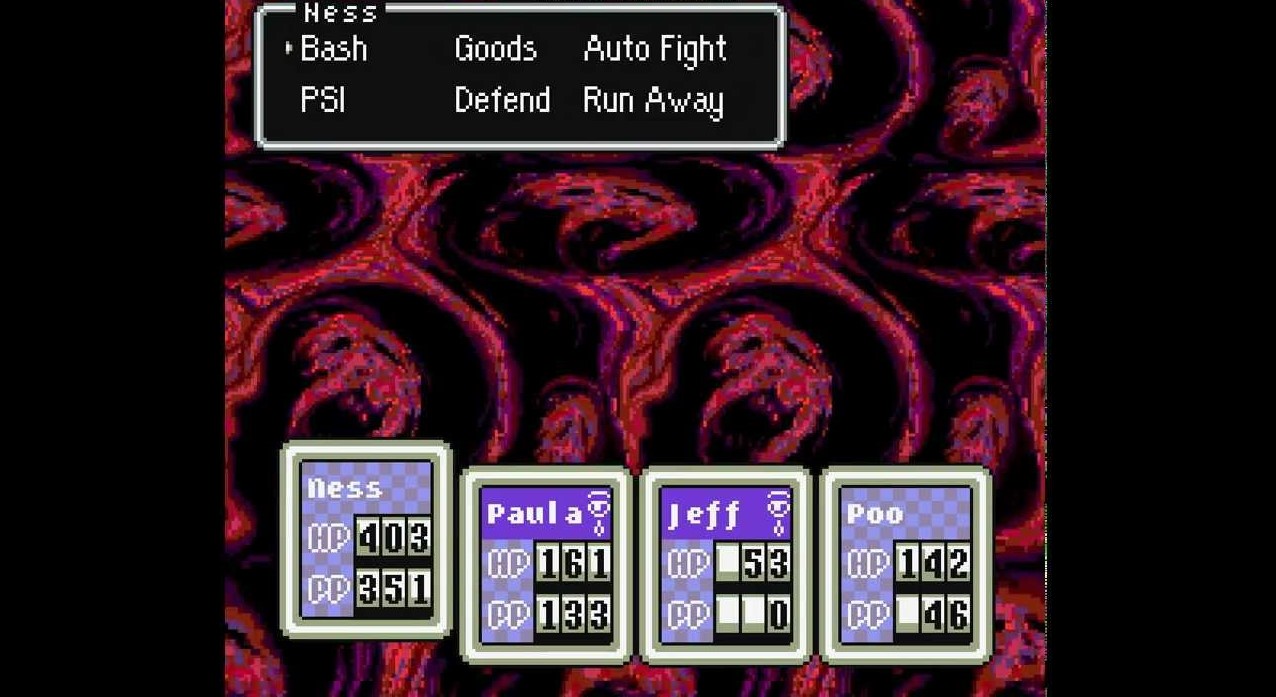
For instance, once reaching the final battleground to face Giygas, the four characters do all that they can tactically. At the beginning of the fight, the player uses Jeff’s Heavy Bazooka and each other characters’ respective PSI attacks. However, it comes to a point where physical damage does not harm Giygas at all. It is literally with the power of friendship that Giygas is defeated. With her power of telepathy, Paula prays a total of nine times to the different groups of people that they have befriended throughout their journey. These NPCs hear Paula’s prayers and begin to pray for the safety of the group. Giygas’ defenses lower and with each added group of friends praying for Ness and his friends Giygas takes progressively more damage. With their friends’ unwavering support and praying, Giygas eventually becomes a bunch of static and is defeated at last.
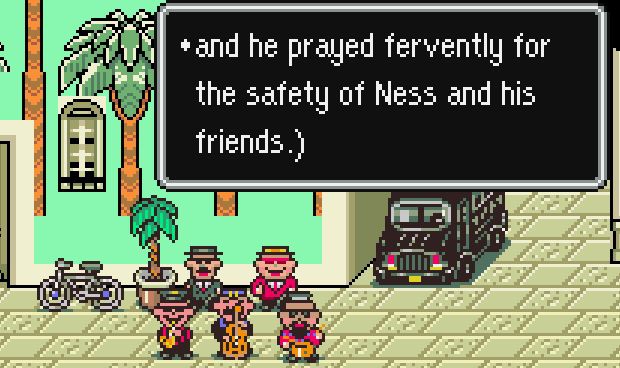
Just as “Earthbound’s” NPCs play a valuable and supportive role to the player, this is also reflected in “Undertale.” Just before the ending of the True Pacifist run of the game, all of the protagonist’s friends are captured; they all give words of encouragement just before the final battle begins. Additionally, it is only by attempting to save the final boss, Asriel Dreemurr, that the encounter ends. With this, we can see that the value of friendship explored by “Earthbound” inspired another piece of media to do the same.
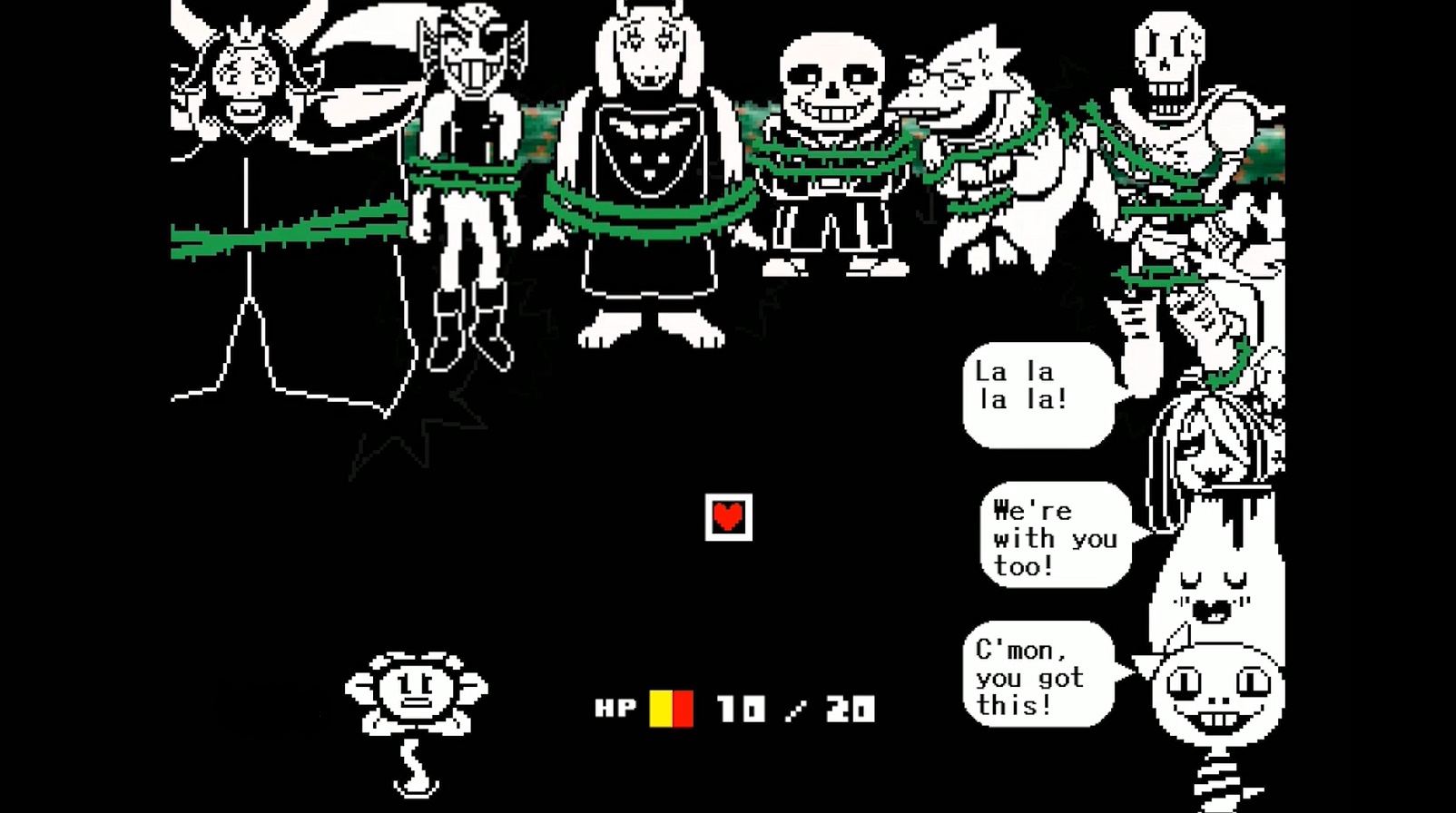
Is This Real Life?
Sources indicate that practicing skills within the constraint of a video game can help people build these skills for the real world; these skills can be related to communication, creative thinking, hand-eye coordination, and a variety of others. “Earthbound,” on the other hand, encourages and values friendship. The game is literally unplayable and unfinishable without learning how to work in tandem with others and the aid of friends; these values are even reinforced within the soundtrack with track titles such as “Because I Love You” and “Good Friends/Bad Friends.”
Creating a video game that requires friendship to complete it emphasizes its necessity within our own lives outside of the video game world. Additionally, after dedicating hours upon hours to a game, not only are skills developed but naturally, ideals and perceptions change as well. In the case of “Earthbound,” by having four playable characters instead of one, progressing by the kindness of NPCs, and defeating the final boss by asking for help from others, it translates to the real world as: Friendship overcomes all.
